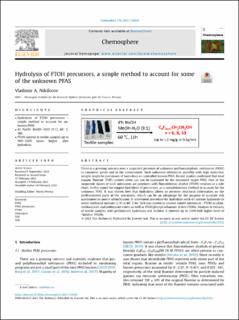| dc.contributor.author | Nikiforov, Vladimir | |
| dc.date.accessioned | 2021-05-12T08:00:53Z | |
| dc.date.available | 2021-05-12T08:00:53Z | |
| dc.date.created | 2021-05-10T18:02:06Z | |
| dc.date.issued | 2021 | |
| dc.identifier.citation | Chemosphere. 2021, 276, 130044. | en_US |
| dc.identifier.issn | 0045-6535 | |
| dc.identifier.uri | https://hdl.handle.net/11250/2755091 | |
| dc.description.abstract | There is a growing concern over a suspected presense of unknown perfluoroaliphatic substances (PFAS) in consumer goods and in the environment. Such unknown substances, possibly with high molecular weight, might be precursors of hazardous or controlled known PFAS. Recent studies confirmed that totalorganicfluorine (TOF) content often can not be explained by the measured target PFAS. One of the suspected classes of such unknowns are polymers with fluorotelomer alcohol (FTOH) residues in a sidechain. In this report we suggest hydrolysis of precursors, as a complementary method to account for the unknown PFAS. It was shown here that hydrolysis allows to preserve structural information on the perlfuorinated parts of the precursors, which can be an advantage for the purpose of accurate risk assessment or source identification. A convenient procedure for hydrolysis with 4% sodium hydroxide in water-methanol mixture (1:9) at 60 °C for 16 h was shown to convert model substances - FTOH acrylate, methacrylate and isobutyrate esters as well as FTOH phenylcarbamate to free FTOHs. Analysis of extracts of textile samples with preliminary hydrolysis and without it showed up to 1300-fold higher level of “hidden” FTOHs. | en_US |
| dc.language.iso | eng | en_US |
| dc.rights | Navngivelse 4.0 Internasjonal | * |
| dc.rights.uri | http://creativecommons.org/licenses/by/4.0/deed.no | * |
| dc.title | Hydrolysis of FTOH precursors, a simple method to account for some of the unknown PFAS | en_US |
| dc.type | Peer reviewed | en_US |
| dc.type | Journal article | en_US |
| dc.description.version | publishedVersion | en_US |
| dc.rights.holder | © 2021 The Author(s). Published by Elsevier Ltd. | en_US |
| dc.source.pagenumber | 6 | en_US |
| dc.source.volume | 276 | en_US |
| dc.source.journal | Chemosphere | en_US |
| dc.identifier.doi | 10.1016/j.chemosphere.2021.130044 | |
| dc.identifier.cristin | 1909295 | |
| dc.relation.project | Miljødirektoratet: 18087116 | en_US |
| dc.source.articlenumber | 130044 | en_US |
| cristin.ispublished | true | |
| cristin.fulltext | original | |
| cristin.qualitycode | 1 | |

